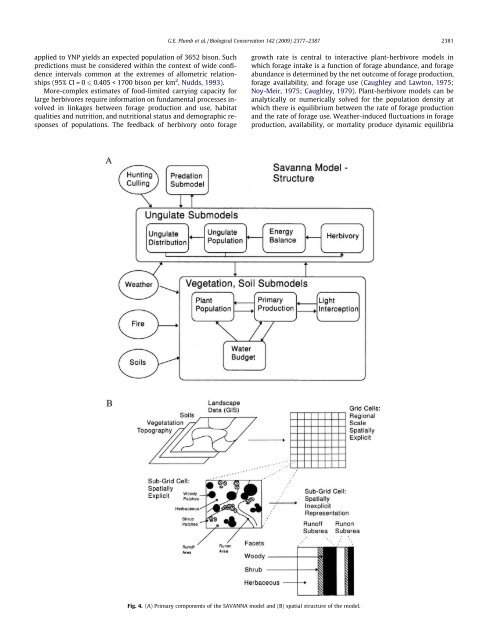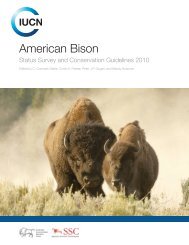Carrying capacity, migration, and dispersal in ... - ResearchGate
Carrying capacity, migration, and dispersal in ... - ResearchGate
Carrying capacity, migration, and dispersal in ... - ResearchGate
Create successful ePaper yourself
Turn your PDF publications into a flip-book with our unique Google optimized e-Paper software.
applied to YNP yields an expected population of 3652 bison. Such<br />
predictions must be considered with<strong>in</strong> the context of wide confidence<br />
<strong>in</strong>tervals common at the extremes of allometric relationships<br />
(95% CI = 0 6 0.405 < 1700 bison per km 2 , Nudds, 1993).<br />
More-complex estimates of food-limited carry<strong>in</strong>g <strong>capacity</strong> for<br />
large herbivores require <strong>in</strong>formation on fundamental processes <strong>in</strong>volved<br />
<strong>in</strong> l<strong>in</strong>kages between forage production <strong>and</strong> use, habitat<br />
qualities <strong>and</strong> nutrition, <strong>and</strong> nutritional status <strong>and</strong> demographic responses<br />
of populations. The feedback of herbivory onto forage<br />
G.E. Plumb et al. / Biological Conservation 142 (2009) 2377–2387 2381<br />
growth rate is central to <strong>in</strong>teractive plant-herbivore models <strong>in</strong><br />
which forage <strong>in</strong>take is a function of forage abundance, <strong>and</strong> forage<br />
abundance is determ<strong>in</strong>ed by the net outcome of forage production,<br />
forage availability, <strong>and</strong> forage use (Caughley <strong>and</strong> Lawton, 1975;<br />
Noy-Meir, 1975; Caughley, 1979). Plant-herbivore models can be<br />
analytically or numerically solved for the population density at<br />
which there is equilibrium between the rate of forage production<br />
<strong>and</strong> the rate of forage use. Weather-<strong>in</strong>duced fluctuations <strong>in</strong> forage<br />
production, availability, or mortality produce dynamic equilibria<br />
Fig. 4. (A) Primary components of the SAVANNA model <strong>and</strong> (B) spatial structure of the model.










